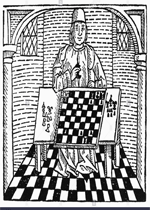Cessolis Jacobus De
 Dominican monk from north-west Italy who wrote the most famous and successful “chess morality’:Liber de moribus Hominum et officiis Nobilum, sometime between 1275 and 1300. The appearance of Chessolis’s name is about 30 forms has led to assertions that he was French, Spanish or Greek, but most likely he came from Chessole near Asti, Italy and was a Lombard. In 1317-18 he was in charge of the inquisition in Genoa. It consisted of 24 chapters in 4 books and was translated by Saxton into English (via a French edition) and published in the 1470s as the Game and Playe of the Chesse – one of the first printed books in English and widely admired for the woodcuts of the second edition, was one of the numerous translations. ‘Moralities’ were popular at the time. More than hundred manuscript copies are extant. For example one writer gave each piece of feminine attribute the representation of a virtue, one that a good woman ought to have. Chess moralities gave pieces and their moves human characteristics, e.g. pawns were poor men, their move is straight except when they take anything! or: the knight’s move is a combination of a straight move and an obligue one. The straight part is his legal power to collect rents etc. The oblique part is his extortion and wrong doing. Because Cessole wanted to extend his ALLEGORIES Chess ‘moralities’ often gave wrong ideas about chess, but they spread knowledge of the game’s existence all over Europe and they broke down ecclesiastic prejudice against chess. In the last quarter of the 13th century Cessole gave a series of sermons using chess as a frame-work. Because they were so popular Cessole made a book of them, using De Regimine Principum by Egidius Romanus (Guido Colonna) as his basis. The result was Liber de moribus Hominum et officiis Nobilum ac Popularium super ludo scacchorum. The first of many printed versions appeared in Utrecht in 1473. Caxton’s first edition was printed in Bruges around 1475, and the second edition in London around 1481. Many copies were illustrated by Miniatures on chess thematic, one of them was printed as postmark in Czechoslovakia.
Dominican monk from north-west Italy who wrote the most famous and successful “chess morality’:Liber de moribus Hominum et officiis Nobilum, sometime between 1275 and 1300. The appearance of Chessolis’s name is about 30 forms has led to assertions that he was French, Spanish or Greek, but most likely he came from Chessole near Asti, Italy and was a Lombard. In 1317-18 he was in charge of the inquisition in Genoa. It consisted of 24 chapters in 4 books and was translated by Saxton into English (via a French edition) and published in the 1470s as the Game and Playe of the Chesse – one of the first printed books in English and widely admired for the woodcuts of the second edition, was one of the numerous translations. ‘Moralities’ were popular at the time. More than hundred manuscript copies are extant. For example one writer gave each piece of feminine attribute the representation of a virtue, one that a good woman ought to have. Chess moralities gave pieces and their moves human characteristics, e.g. pawns were poor men, their move is straight except when they take anything! or: the knight’s move is a combination of a straight move and an obligue one. The straight part is his legal power to collect rents etc. The oblique part is his extortion and wrong doing. Because Cessole wanted to extend his ALLEGORIES Chess ‘moralities’ often gave wrong ideas about chess, but they spread knowledge of the game’s existence all over Europe and they broke down ecclesiastic prejudice against chess. In the last quarter of the 13th century Cessole gave a series of sermons using chess as a frame-work. Because they were so popular Cessole made a book of them, using De Regimine Principum by Egidius Romanus (Guido Colonna) as his basis. The result was Liber de moribus Hominum et officiis Nobilum ac Popularium super ludo scacchorum. The first of many printed versions appeared in Utrecht in 1473. Caxton’s first edition was printed in Bruges around 1475, and the second edition in London around 1481. Many copies were illustrated by Miniatures on chess thematic, one of them was printed as postmark in Czechoslovakia.



